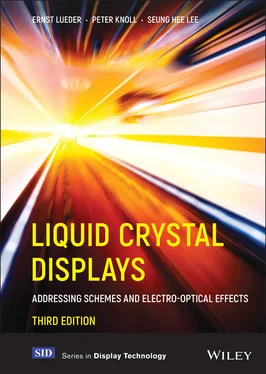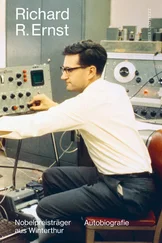Ernst Lueder - Liquid Crystal Displays
Здесь есть возможность читать онлайн «Ernst Lueder - Liquid Crystal Displays» — ознакомительный отрывок электронной книги совершенно бесплатно, а после прочтения отрывка купить полную версию. В некоторых случаях можно слушать аудио, скачать через торрент в формате fb2 и присутствует краткое содержание. Жанр: unrecognised, на английском языке. Описание произведения, (предисловие) а так же отзывы посетителей доступны на портале библиотеки ЛибКат.
- Название:Liquid Crystal Displays
- Автор:
- Жанр:
- Год:неизвестен
- ISBN:нет данных
- Рейтинг книги:4 / 5. Голосов: 1
-
Избранное:Добавить в избранное
- Отзывы:
-
Ваша оценка:
- 80
- 1
- 2
- 3
- 4
- 5
Liquid Crystal Displays: краткое содержание, описание и аннотация
Предлагаем к чтению аннотацию, описание, краткое содержание или предисловие (зависит от того, что написал сам автор книги «Liquid Crystal Displays»). Если вы не нашли необходимую информацию о книге — напишите в комментариях, мы постараемся отыскать её.
THE NEW EDITION OF THE GOLD-STANDARD IN TEACHING AND REFERENCING THE FUNDAMENTALS OF LCD TECHNOLOGIES
Liquid Crystal Displays — читать онлайн ознакомительный отрывок
Ниже представлен текст книги, разбитый по страницам. Система сохранения места последней прочитанной страницы, позволяет с удобством читать онлайн бесплатно книгу «Liquid Crystal Displays», без необходимости каждый раз заново искать на чём Вы остановились. Поставьте закладку, и сможете в любой момент перейти на страницу, на которой закончили чтение.
Интервал:
Закладка:
23 Chapter 24Figure 24.1 Comparison of schematic electrode structure and on-state molecular orientation showing differences between IPS and FFS devices. LC orientations at electrode positions a , b , c are quite different each other such that it has an optic axis at a but no optic axis at c Figure 24.2 Time-dependent transmittance curves in the FFS device when an operating voltage is applied for a LC with positive dielectric anisotropy. The LC switches at first at electrode position c by dielectric torque, giving rise to transmittance around region c only after relaxation of 5 ms and then switches at a ( a ′) by elastic torque sequentially, giving rise to transmittance even above region a after relaxation of 35 msFigure 24.3 Comparisons of calculated voltage-dependent transmittance curves (a) and electrodeposition dependent transmittance (b) between +LC and –LC in the FFS devices. Here the following cell and LC parameters are used for calculation: w = 3 μ m, l = 4.5 μ m, d = 3.5 μ m, K 11 =9.6 pN, K 22 =5.3 pN, K 33 =11.6 pN, = 84 m Pa s, Δ ε = 4 (–4) for +LC (–LC), Δ n = 0.1028 at 550 nm, angle of initial LC director with respect to Ey =80° (10 °) for +LC (–LC). The transmittance of two parallel polarizers is 36.5 percentFigure 24.4 Structure of 5CB (4-cyano-40-pentylbiphenyl), which shows typical nematic phase at room temperature. With random orientation of head to tail of LCs, there is no induced polarity in the liquid crystal director field. In a splay orientation with collective arrangement of head to tail of LCs, the polarization P is induced, which can couple with an applied electric fieldFigure 24.5 LC molecular orientation in a white state and its corresponding transmittance without (normal mode) and with (flexoelectric mode) P fin IPS cell. In the normal mode, the transmittance does not occur above the centre of the electrodes. In the flexoelectric mode, P f1and P f2with mirror symmetry are formed along the field direction near the edges of electrodes. During the +frame, the coupling between E and P f1occurs in a constructive way while the coupling between E and P f2occurs in a destructive way so that transmittance above the signal electrode remains low but that above the common electrode becomes very high. During the –frame, the coupling is reversed and so is the transmittance behaviour. Here w = 5 μ m, l = 5 μ m, d = 4 μ m, Δ ε = 6, an initial angle between LC director and Ey =80°Figure 24.6 Experimental observation of flexoelectric effect in the IPS cell. (a) Schematics of the cell geometry (blue and red arrows represent the electric field vector). (b) Voltage-dependent transmittance curves as a function of driving frequencies with a square wave. (c) Local time-dependent transmittance on the indicated location by black arrows under the application of ~3.7 V (50 percent of the maximum transmittance). Insets: POM images with scale bar (10 μ m) for positive (top) and negative (bottom) frames. (d) Local time-averaged transmittance after the curves saturated and its standard deviation with respect to the driving frequency f . Here, w = 5 μ m , l = 5 μ m, d = 5 μ m, Δ ε = 4, an initial angle between LC director and Ey =80 °. This figure was reproduced from Kim et al . (2016), Sci. Rep. , 6, pp. 35254, fig. 1 with permission by Springer NatureFigure 24.7 Simulation and experimental results showing typical spatial brightness appearance in the FFS mode without and with flexoelectric coefficients. Along fringe electric field lines, a splay deformation occurs, generating P f1and P f2each at both regions of pixel electrode edge ( b and b ′ in Figure 24.2). The simulation without e band e s(normal mode) shows relatively low transmittance above the centre of electrodes ( a and a ′) compared with that at the edge of the electrode ( c ), which exactly matches transmittance oscillation in experiments along the y -direction. The simulation with e band e s(flexoelectric mode) shows large transmittance change above the centre of the electrodes (A and B) such that during +frame, the transmittance at A (B) decreases (increases) compared with in the normal mode. During the –frame, the transmittance change is reversed, resulting in increased (decreased) transmittance at A (B). Experimental results of 1 Hz driving exhibit exactly the same behaviour with the simulation results. Here w p =3 μ m, l ′ = 5 μ m, d = 4 μ m, thickness of insulator ( h ) = 0.4 μ m, Δ ε = 3.8, an initial angle between LC director and Ey =80°Figure 24.8 Microphotographs of pixels showing large flexoelectric effect with +LC (a, b) and minimized flexoelectric effect with –LC (c, d) in FFS TFT-LCDs with IGZO TFTs and (e) time-dependent luminance during frame change, showing larger fluctuation in +LC than in –LC. This figure was reproduced from Miyake et al . (2016), SID 47 , pp. 592–595, fig. 3–5 with permission by The Society for Information DisplayFigure 24.9 Development history of IPS mode and IPS TFT-LCDs. The hatched arrows indicate mass production. This figure was reproduced from Kondo et al . (2005), SID 36 , pp. 978–981, fig. 2 with permission by The Society for Information DisplayFigure 24.10 (a) Schematic pixel structure of U-FFS TFT-LCD. Microphotographs of pixel in TFTLCDs: (b, c) IPS (b) and IPS-Pro (FFS) (c) in a white state. This figure was reproduced from Lee et al . (2001), SID 32 , pp. 484–487, fig. 6 and Ono et al . (2005), SID 36 , pp. 1848–1851, fig. 1 with permission by The Society for Information DisplayFigure 24.11 Schematic comparison of cross-sectional pixel structures near data line and simulated transmittance between advanced FFS (AFFS) (a) and high-aperture-ratio FFS (HFFS) (b) modes. The insulating layers between pixel and common electrodes are inorganicFigure 24.12 Comparison of voltage-dependent transmittance curves in high-resolution mobile TFTLCDs. The high-aperture-ratio FFS (HFFS) mode shows the highest transmittance among all LC modes, and even much better than the advanced FFS (AFFS) mode, as also shown in the microscopic images of pixels. This figure was reproduced from Lim et al . (2006), IDW’06 , pp. 807–808, fig. 2 and table 1 with permission by The Society for Information Display and website of HYDIS Co.Figure 24.13 Zigzag pixel TFT arrangement in IPS-Pro II. This figure was reproduced from Ono et al . (2007), IDW’07 , pp. 67–70, fig. 1 with permission by The Society for Information DisplayFigure 24.14 History of IPS technology and comparison of cross-sectional pixel structures between IPS-Pro (a) and IPS-Pro Next (b). This figure was reproduced from Ono et al . (2012), IDW’12 in conjunction with Asia Display , pp. 933–936, table 1 and fig. 1 with permission by The Society for Information DisplayFigure 24.15 Front-view photographs of pixels in 47-inch LCDs in IPS-Pro and IPS-Pro-Next. This figure was reproduced from Ono et al . (2012), IDW’12 in conjunction with Asia Display , pp. 933–936, table 3 with permission by The Society for Information DisplayFigure 24.16 Microphotographs of pixels in iPad and mobile phones utilizing the FFS modeFigure 24.17 Timing chart for a refresh rate of 90 Hz LCD with 1700 scan lines (a) and 120 Hz LCD with 2432 scan lines (b). Here, the horizontal axis shows time, the vertical axis shows the panel position. This figure was reproduced from T. Matsushima et al . (2018), SID 49 , pp. 667–670, fig. 6 with permission by The Society for Information DisplayFigure 24.18 Comparison of pixel structure between conventional FFS (a) and ip-SFR (b) modes and its corresponding LC molecular orientation and transmittance in a voltage-on state. The second row indicates transmittance in the cross-sectional line I–I′ . Both modes have the same electrode layers but different shape of common electrode. This figure was reproduced from Katayama et al . (2018), SID 49 , pp. 671–673, fig. 4 with permission by The Society for Information DisplayFigure 24.19 (a, b)Cross-section of the SL-IPS panel showing initial condition with electrodes and LC directors (a) and LC directors in a voltage-on state with equipotential line contours (b). Here, LC directors located in vertical lines do not switch and the distance l between these two lines exists, orthogonal to cell gap d . (c,d) Top view of desired (c) and undesired (d) status of LC director distribution with applied voltage and its corresponding luminance photomicrographs of desired (e) and undesired (f) status with applied voltage. The alternate bright and dark stripes of luminance in the desired state change to irregular in the undesired state (circle). (g) Electrode structure of SL-IPS to control the rotating direction of LC directors with trunk and branch parts. (h) Details of equipotential lines and vector orientation lines with electrode structure. The black bars indicate LC directors. (i) In-plane luminance distribution in SLC-IPS test cell. This figure was reproduced from Matsushima et al . (2018), J. Soc. Inf. Disp ., 26(10) , pp. 602–609, fig. 4-8 with permission by The Society for Information DisplayFigure 24.20 Schematic cross-sectional view of the UFS device with LC directors and electric field lines in dark (a) and bright (b) state. Here, the LC medium exists under two crossed polarizers. Two electrode layers on the bottom substrate exist with a passivation layer between them as in the FFS mode and a common electrode exists on the top substrate. The common electrode has open gap g and the size of a pixel electrode can be adjustable depending on display resolutions. The arrows indicate the electric field direction between pixel and common electrodes. In the voltage-on state, LC directors experience bend deformation as indicated in Figure 24.1(b). This figure was reproduced from Yoon et al . (2018), SID 49 , pp. 34142–34149, fig. 1 with permission by The Society for Information DisplayFigure 24.21 Calculated electrode position-dependent transmittances at three different voltages when g is 1 μ m (a), 2 μ m (b) and 3 μ m (c) in the UFS cell. (d) Calculated voltage-dependent transmittances at three different g -values and (e) time-dependent transmittance curves in the FFS and UFS devices. In the FFS device, the electrode width and gap between patterned electrodes are 3 and 4.5 μ m, respectively. The thickness of the passivation layer is 300 nm. The physical properties of LCs tested are as follows: dielectric anisotropy Δ ε = 8.2, birefringence Δ n = 0.1148 at 550 nm, rotational viscosity γ = 80 mPa s, splay/twist/bend elastic constants = 16.9/8.42/19.2 in pN and the d is 4 m. The A and P in (d) represent the analyser and polarizer, respectively. This figure was reproduced from Yoon et al . (2018), SID 49 , pp. 34142–34149, fig. 2 with permission by The Society for Information Display.Figure 24.22 Evaluation of optical crosstalk considering 3 × 3 pixels using a three-dimensional simulator: (a) top-view of luminance profile when three pixels in the second row are on-state; (b) luminance profile along horizontal direction in which it is defined well within 4 μ m. This figure was reproduced from Yoon et al . (2018), SID 49 , pp. 34142–34149, fig. 5 with permission by The Society for Information DisplayFigure 24.23 Schematic diagram of a pixel structure in viewing-angle-controllable FFS LCD. This figure was reproduced from Wang, L. et al . (2018), SID 49 , pp. 1765–1768, fig. 1 with permission by The Society for Information DisplayFigure 24.24 Photographic images of 13.3-inch viewing angle controllable FFSLCD in WVA(a) and NVA (b) modes. This figure was reproduced from Wang, L. et al . (2018), SID 49 , pp. 1765–1768, fig. 3 with permission by The Society for Information DisplayFigure 24.25 Viewing angle dependence of contrast ratio in both wide (WVA) and narrow viewing angle (NVA) modes. This figure was reproduced from Wang, L. et al . (2018), SID 49 , pp. 1765–1768, fig. 6 with permission by The Society for Information DisplayFigure 24.26 Configuration of FFS-based privacy LCD: (a) conventional; (b) new. This figure was reproduced from Murata et al . (2020), SID 51 , pp. 874–877, fig. 1 with permission by The Society for Information DisplayFigure 24.27 Schematic LC orientation associated with generated electric field in a white state in wide and narrow view modes: (a) conventional; (b) new. This figure was reproduced from Murata et al . (2020), SID 51 , pp. 874–877, fig. 2 with permission by The Society for Information DisplayFigure 24.28 Appearance of the 5.3-inch prototype of new switchable LCD in wide-view mode, normal privacy mode and stronger privacy mode. This figure was reproduced from Murata et al . (2020), SID 51 , pp. 874–877, fig. 6 with permission by The Society for Information Display
Читать дальшеИнтервал:
Закладка:
Похожие книги на «Liquid Crystal Displays»
Представляем Вашему вниманию похожие книги на «Liquid Crystal Displays» списком для выбора. Мы отобрали схожую по названию и смыслу литературу в надежде предоставить читателям больше вариантов отыскать новые, интересные, ещё непрочитанные произведения.
Обсуждение, отзывы о книге «Liquid Crystal Displays» и просто собственные мнения читателей. Оставьте ваши комментарии, напишите, что Вы думаете о произведении, его смысле или главных героях. Укажите что конкретно понравилось, а что нет, и почему Вы так считаете.












